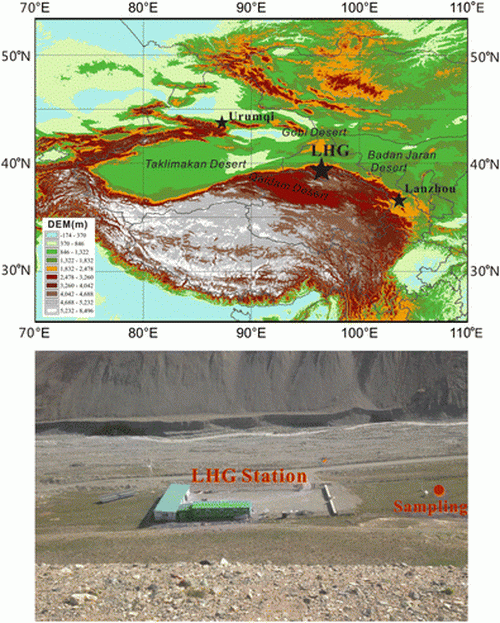Scientists reveal the relationship between trace elements in precipitation and atmospheric pollution in western Qilian Mountains
Updatetime:2017-05-27From:
【Enlarge】【Reduce】
The Laohugou (LHG) glacier basin, located on the northern slope of the western Qilian Mountain, is typical continental climatic conditions. There are many cities and towns surrounding the LHG glacier region, and many large cities in the surrounding area in Northwest China could have a large effect on the atmospheric conditions, bringing large amounts of pollutants over the alpine glacier basin.
Trace metals in precipitation can indicate regional pollution of the atmospheric environment on a large scale. Trace element pollution resulting from anthropogenic emissions is evident throughout most of the atmosphere and has the potential to create environmental and health risks. Thus, the observation of trace elements in precipitation of the alpine region could reflect the large regional scale of atmospheric pollution conditions.
However, little research has been carried out on large-scale atmospheric trace element deposition via precipitation in the western Qilian Mountains of the northwest regions in China, especially those caused by anthropogenic emissions.
Recently, a research group from the State Key Laboratory of Cryospheric Sciences, Northwest Institute of Eco-Environment and Resources (NIEER) of the Chinese Academy of Sciences has collected precipitation samples over an entire year in the LHG glacier basin, to present the concentrations of trace metals , enrichment factors (EFs) and their seasonal variation, and evaluated particle morphology and chemical composition analysis of the precipitation in each season by using a TEM-EDX (transmission electron microscope-energy dispersive X-ray spectrometer).
The research results showed that trace metals indicated an obvious higher concentrations and higher EFs in winter, while they showed relatively lower concentrations and lower EFs in summer and autumn, implying enhanced winter pollution of the regional atmosphere throughout the year in Northwest China using precipitation observations in the free troposphere.
In total, this research indicated that the atmospheric environment in western Qilian Mountains also showed enhanced anthropogenic pollution in winter, probably mainly caused by regional fossil fuel combustion.
This research achievement has been published in Environmental Science and Pollution Research.
This study is financially supported by the National Natural Science Foundation of China (41421061, 41671062), the Youth Innovation Promotion Association, CAS (2015347), and the West Light Program for Talent Cultivation of the CAS.
Contact:
DONG Zhiwen
E-mail: dongzhiwen@lzb.ac.cn
State Key Laboratory of Cryospheric Sciences, Northwest Institute of Eco-Environment and Resources (NIEER) of the Chinese Academy of Sciences, Lanzhou, 730000, P. R. China.

Fig. Location map of the LHG glacier basin on the northeast Tibetan Plateau (a), and the sampling sites in the alpine station of the LHF glacier basin (b) (Image by DONG Zhiwen)
Appendix




